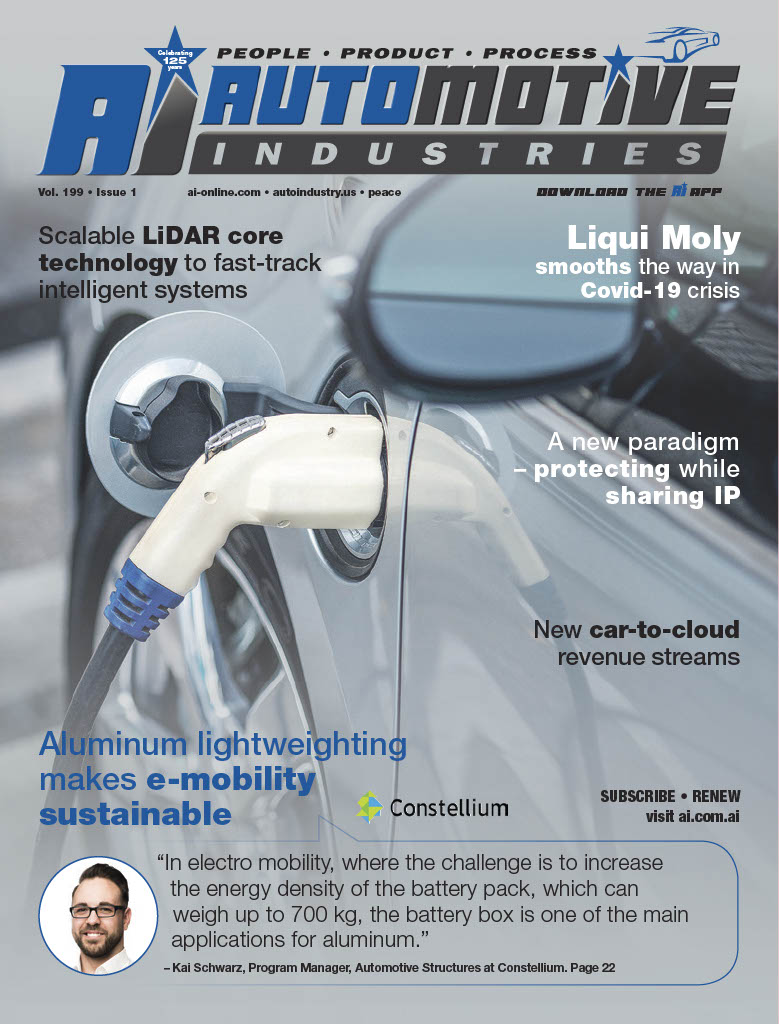
In the drive for sustainability and reduced carbon footprint, aluminum has become a material of choice for body parts and structural components in electric vehicles, as well as those with internal combustion drivetrains.

According to the Washington-based Aluminum Association, automakers are taking a more holistic approach to creating cost-effective, efficient, eco-friendly and safe vehicles. Using more aluminum to reduce weight can be a catalyst for cost savings throughout the vehicle by accommodating smaller engines and consolidating assembly into fewer parts. This can all be done without sacrificing safety or performance.
Greater use of aluminum is supported by a 2016 study by Forschungsgesellschaft Kraftfahrwesen mbH Aachen (fka) which found that, while keeping the same crash performance as steel, lightweighting through aluminum reduces both the production and the operating costs of electric vehicles since a lighter car needs fewer batteries and less electricity to travel the same distance. “Therefore, lightweighting should be encouraged as it is key to improve the market uptake of electric vehicles” the study concludes.
Aluminum is already used in automobile manufacturing whenever components need to be made lighter. Thanks to its strength and adaptability, it is the most suitable material for battery enclosures. High-strength crash-proof alloys offer protection, optimize weight, and as extrusions, they offer additional possibilities.
One of the global leaders in innovative and high value-added aluminum products and solutions in the automotive, aerospace and packaging markets is Constellium. The company, which has its headquarters in France, is the only supplier of rolled and extruded aluminum solutions to the world automotive market.
Automotive Industries (AI) asked Kai Schwarz, Program Manager, Automotive Structures at Constellium what the proven advantages of aluminum include.
Schwarz: A lower weight, a greater range and improved driving dynamics – the goals of lightweight design – have been clearly defined. In e-mobility, one challenge is to increase the energy density of the battery pack, which can weigh up to 700 kg, by reducing the structural weight as much as possible. However, the fun of driving the vehicle and its performance must not be reduced. Aluminum has proven to be the material of choice when it comes to limiting the weight of modern vehicles while at the same time improving their performance. In electro mobility, the battery box is one of the main applications for aluminum.
AI: What are the main advantages of using aluminum?
Schwarz: Aluminum offers excellent properties for lightweight vehicle construction. It is easy to extrude, significantly more heat-conductive than steel, extremely corrosion-resistant without any protection layer, it is recyclable and has excellent crash properties. These make it particularly interesting for electro-mobility and the protection of sensitive high-voltage components.
AI: And what are the advantages of aluminum extrusions?
Schwarz: The main job of battery enclosures is to protect battery cells from environmental influences. What is particularly challenging to manage is penetration from the sides of a vehicle in the event of a crash, as the kinetic energy of the intruding elements may be extremely high.
Frames made of multi-chamber extrusions are particularly efficient at protecting the battery cells as they spread the kinetic energy from the collision and absorb it through plastic deformation. This effect may be even more efficient if the extrusion is made out of Constellium’s latest generation of 6xxx family alloys (e.g. HSA6™ or HCA6™). The goal is to avoid any penetration of the battery cells. Some OEMs don’t allow even 1 mm of intrusion into the battery enclosure.
AI: What are the other design advantages?
Schwarz: There is almost no limit to the shape of extruded geometrical components. Another advantage is that it is technically relatively simple to integrate functions. For example, the thermal management and bottom intrusion protection may be combined into one single structure composed of large extrusions joined through welding or adhesive bonding. This design approach strongly depends of the overall geometrical boundary conditions, and of the volumes to be produced.
Constellium is also developing CALD solutions®, a thermal management device which combines active and passive cooling by using a Phase Change Material (PCM) within the extrusions. This smooths the temperature curves and reduces thermal peaks when a lot of energy in a short time is used or during highspeed charging. With this solution the entire active cooling system can be designed for standard situations and not necessarily for worst-cases.
AI then asked Olivier Rebuffet, Program Manager, Automotive Rolled Products R&D at Constellium whether aluminum is suitable for the bottom plates of battery boxes.

Manager, Automotive Rolled
Products R&D at Constellium
Rebuffet: Any intrusion through the undercarriage in the event of an accident is usually characterized by high kinetic energy, but at a lower object weight than other body parts. Given these parameters, the use of aluminum sheets allows the effective management of forces resulting from the vehicle being involved in an incident where objects are pushed or forced against the bottom.
Overall, this solution remains an excellent techno-economical compromise for the undercarriages of electric vehicles. As for the extruded frames, the use of latest generation Constellium solutions offers additional lightweighting: Coralex® is used for higher gauges and extended corrosion resistance, while Securalex® offers better recyclability.
AI: How does multi-layer brazed aluminum help manage cooling?
Rebuffet: Battery cells usually lose efficiency when subjected to high temperatures. Appropriate battery enclosure design provides a solution by avoiding heat build-up though a so-called “cooling plate’’. Aluminum offers a light and efficient solution for this: brazed multi-layer cooling plates. The major advantage of this solution is the flexibility it provides in the design of cooling channels. This allows designers to remove heat without having to compromise the structural design of the vehicle.
AI: What is going to drive the growth of aluminum in e-vehicles?
Rebuffet: There is going to be a continued focus on lightweighting, to optimize performance (in particular acceleration and range).
Aluminum is the ideal solution:
• To reduce body-in-white weight without compromising on safety (aluminum doors offer 25 kg lightweighting for the same performance)
• For cost-effective battery enclosures which integrate functions such as cooling and crash management. This can be achieved through the use of a range of aluminum extruded, monolithic and multi-layer rolled products. Aluminum’s position as a material of choice will be supported through optimized design which cuts weight and assembly costs. The use of a single alloy family in a vehicle will increase recyclability and the scrap value of the metal at the end-of-life.













More Stories
Some Ways How Motorists End Up in Collisions at U-Turns
Maximise Margins with Proven PPF Tactics
Finding the Car Boot Release Button – Tips and Tricks